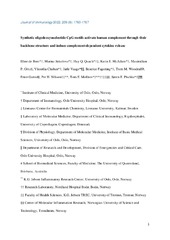Blar i forfatter "Nilsson, Per"
-
Synthetic Oligodeoxynucleotide CpG Motifs Activate Human Complement through Their Backbone Structure and Induce Complement-Dependent Cytokine Release
de Boer, Eline; Sokolova, Marina; Quach, Huy Quang; Mc Adam, Karin Ekholt; Götz, Maximilian P.; Chaban, Viktoriia; Vaage, Ingvar Jarle; Fageräng, Beatrice Linnea Christina; Woodruff, Trent M.; Garred, Peter; Nilsson, Per; Mollnes, Tom Eirik; Pischke, Soeren (Journal article; Tidsskriftartikkel; Peer reviewed, 2022-11-01)Bacterial and mitochondrial DNA, sharing an evolutionary origin, act as danger-associated molecular patterns in infectious and sterile inflammation. They both contain immunomodulatory CpG motifs. Interactions between CpG motifs and the complement system are sparsely described, and mechanisms of complement activation by CpG remain unclear. Lepirudin-anticoagulated human whole blood and plasma were ... -
Thrombin Differentially Modulates the Acute Inflammatory Response to Escherichia coli and Staphylococcus aureus in Human Whole Blood
Johnson, Christina; Quach, Huy Quang; Lau, Corinna; Ekholt, Karin; Espevik, Terje; Woodruff, Trent M.; Pischke, Soeren; Mollnes, Tom Eirik; Nilsson, Per (Journal article; Tidsskriftartikkel; Peer reviewed, 2022-06-15)Thrombin plays a central role in thromboinflammatory responses, but its activity is blocked in the common ex vivo human whole blood models, making an ex vivo study of thrombin effects on thromboinflammatory responses unfeasible. In this study, we exploited the anticoagulant peptide Gly-Pro-Arg-Pro (GPRP) that blocks fibrin polymerization to study the effects of thrombin on acute inflammation in ... -
Tuning gelatin-based hydrogel towards bioadhesive ocular tissue engineering applications
Sharifi, Sina; Islam, Mohammad Mirazul; Sharifi, Hannah; Islam, Rakibul; Koza, Darrell; Reyes-Ortega, Felisa; Alba-Molina, David; Nilsson, Per; Dohlman, Claes H.; Mollnes, Tom Eirik; Chodosh, James; Gonzalez-Andrades, Miguel (Journal article; Tidsskriftartikkel; Peer reviewed, 2021-04-17)Gelatin based adhesives have been used in the last decades in different biomedical applications due to the excellent biocompatibility, easy processability, transparency, non-toxicity, and reasonable mechanical properties to mimic the extracellular matrix (ECM). Gelatin adhesives can be easily tuned to gain different viscoelastic and mechanical properties that facilitate its ocular application. We ...


 English
English norsk
norsk

